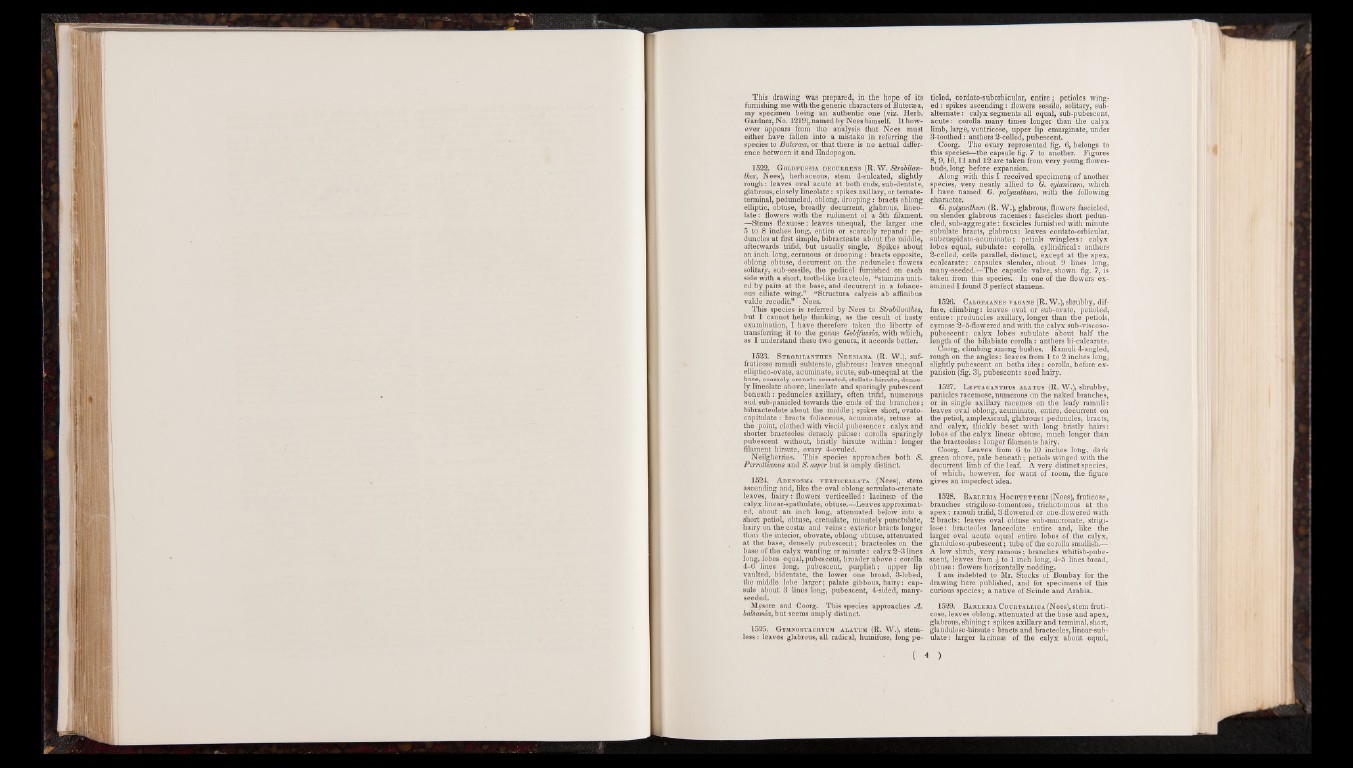
This drawing was prepared, in the hope of its
furnishing me with the generic characters o f Butersea,
my specimen being an authentic one (viz. Herb.
Gardner, No. 1219), named by Nees himself. It however
appears from the analysis that Nees must
either nave fallen into a mistake in referring the
species to Buteraa, or that there is no actual difference
between it and Endopogon.
1522. Goldfussia decurrens (R. W . StrobUan-
thes, Nees), herbaceous, stem 4-sulcated, slightly
rough: leaves oval acute at both ends, sub-dentate,
glabrous, closely lineolate: spikes axillary, or temate-
terminal, peduncled, oblong, drooping: bracts oblong
elliptic, obtuse, broadly decurrent, glabrous, lineolate:
flowers with the rudiment of a 5th filament.
—Stems flexuose: leaves unequal, the larger one
5 to 8 inches long, entire or scarcely repand: peduncles
at first simple, bibracteate about the middle,
afterwards trifid, but usually single. Spikes about
an inch long, cernuous or drooping: bracts opposite,
oblong obtuse, decurrent on the peduncle: flowers
solitary, sub-sessile, the pedicel furnished on each
side with a short, tooth-like bracteole, “stamina united
by pairs at the base, and decurrent in a foliace-
ous ciliate wing.” “Structura calycis ab affinibus
valde recedit” Nees.
This species is referred by Nees to Strobilanthes,
but I cannot help thinking, as the result of hasty
examination, I have therefore taken the liberty of
transferring it to the genus Goldfussia, with which,
as I understand these two genera, it accords better.
1523. Strobilanthes Neesiana (R. W.), suf-
fruticose ramuli subterete, glabrous: leaves unequal
elliptico-ovate, acuminate, acute, sub-unequal at the
base, coarsely crenato-serrated, stellato-hirsute, densely
lineolate above, lineolate and sparingly pubescent
beneath: peduncles axillary, often trifid, numerous
and sub-panicled towards the ends of the branches;
bibracteolate about the middle; spikes short, ovato-
capitulate: bracts foliaceous, acuminate, retuse at
the point, clothed with viscid pubesence: calyx and
shorter bracteoles densely pilose: corolla sparingly
pubescent without, bristly hirsute within: longer
filament hirsute, ovary 4-ovuled.
Neilgherries. This species approaches both &
Perrottianus and & asper but is amply distinct.
1524. Adenosma verticellata (Nees), stem
ascending and, like the oval oblong serrulato-crenate
leaves, hairy: flowers verticelled: la tineas of the
calyx linear-spathulatej obtuse.—Leaves approximated,
about an inch long, attenuated below into a
short petiol, obtuse, crenulate, minutely punctulate,
hairy on the costae and v ein s: exterior bracts longer
than the interior, ob ovate, oblong obtuse, attenuated
at the base, densely pubescent; bracteoles on the
base of the calyx wanting or minute: calyx 2 -3 lines
long, lobes equal, pubescent, broader above: corolla
4 -6 lines long, pubescent, purplish; upper lip
vaulted, bidentate, the lower one broad, 3-lobed,
the middle lobe larger; palate gibbous, hairy: capsule
about 3 lines long, pubescent, 4-sided, many-
seeded.
Mysore and Coorg. This species approaches A.
balsamia, but seems amply distinct.
1525. Gymnostachyum alatum (R. W.), stemless
: leaves glabrous, all radical, humifuse, long petioled,
cordato-suborbicular, entire; petioles winged:
spikes ascending: flowers sessile, solitary, sub-
altemate: calyx segments all equal, sub-pubescent,
acute: corolla many times longer than the calyx
limb, large, ventricose, upper lip emarginate, under
3-toothed: anthers 2-celled, pubescent.
Coorg. The ovary represented fig. 6, belongs to
this species—the capsule fig. 7 to another. Figures
8, 9 ,1 0 ,1 1 and 12 are taken from very young flower-
buds, long before expansion.
Along with this I received specimen* of another
species, very nearly allied to G. culanicum, which
1 have named G. polyanthum, with the following
character.
G. polyanthum (R. W.), glabrous, flowers fascicled,
on slender glabrous racemes: fascicles short peduncled,
sub-aggregate: fascicles furnished with minute
subulate bracts, glabrous: leaves cordato-orbicular,
subcuspidato-acuminate; petiols wingless: calyx
lobes equal, subulate: corolla cylindrical: anthers
2-celled, cells parallel, distinct, except at the apex,
ecalcarate: capsules slender, about 9 lines long,
many-seeded.—The capsule valve, shown fig. 7, is
taken from this species. In one of the flowers examined
I found 3 perfect stamens.
1526. Calopaanes vagans (R. W.), shrubby, diffuse,
climbing: leaves oval or sub-ovate, petioled,
entire: preduncles axillary, longer than the petiols,
cymose 2-5-flowered and with the calyx sub-viscoso-
pubescent: calyx lobes subulate about half the
length of the bilabiate corolla: anthers bi-calcarate.
Coorg, climbing among bushes. Ramuli 4-angled,
rough on the angles: leaves from 1 to 2 inches long,
slightly pubescent on boths ides: corolla, before expansion
(fig. 3), pubescent: seed hairy.
1527. Leptacanthus alatus (R. W.), shrubby,
panicles racemose, numerous on the nakea branches,
or in single axillary racemes on the leafy ramuli:
leaves oval oblong, acuminate, entire, decurrent on
the petiol, amplexicaul, glabrous: peduncles, bracts,
and calyx, thickly beset with long bristly hairs:
lobes of the calyx linear obtuse, much longer than
the bracteoles: longer filaments hairy.
Coorg. Leaves from 6 to 10 inches long, dark
green above, pale beneath; petiols winged with the
decurrent limb of the leaf. A very distinct species,
of which, however, for want of room, the figure
gives an imperfect idea.
1528. Barleria Hochtetteri (Nees), fruticose,
branches strigiloso-tomentose, tricnotomous at the
ap ex; ramuli trifid, 3-flowered or one-flowered with
2 bracts: leaves oval obtuse sub-mucronate, strigi-
lose: bracteoles lanceolate entire and, like tne
larger oval acute equal entire lobes of the calyx,
glanduloso-pubescent; tube of the corolla smallish.—
A low shrub, very ramous; branches whitish-pubescent,
leaves from £ to 1 inch long, 4 -5 lines broad,
obtuse: flowers horizontally nodding.
I am indebted to Mr. Stocks of Bombay for the
drawing here published, and for specimens of this
curious species; a native of Scinde and Arabia.
1529. Barleria Courtallica (Nees), stem fruticose,
leaves oblong, attenuated at tne base and apex,
glabrous, shining: spikes axillary and terminal, short,
glanduloso-hirsute: bracts and bracteoles, linear-subulate:
larger lacineae of the calyx about equal,